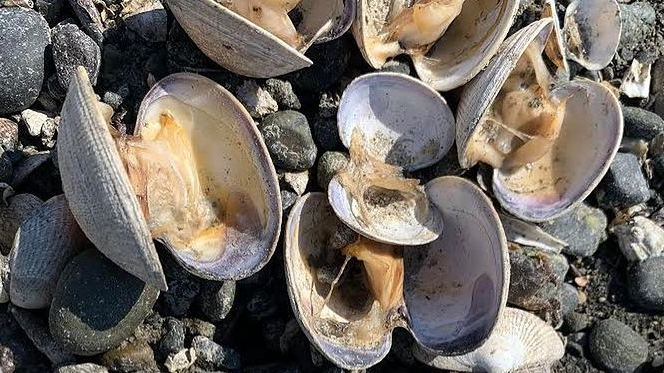Mollusk Massacre: The Heat Wave Is Killing Off Shellfish
In Washington state, temperatures well over 100 degrees leave clams cooked inside their shells.
Our sister site Earther has described how the Pacific Northwest suffered through an historic heatwave this week, with temperatures hitting highs you'd associate more with the desert than with the states best known for their temperate climate and heavy rainfall: 116 degrees in Oregon, 117 degrees in British Columbia, 109 degrees on the Olympic Peninsula in Washington. The latter, which typically enjoys a mild oceanic climate, is home to the Hama Hama Company, a fifth-generation family-run shellfish farm that's been in operation for 99 years. And Hama Hama posted some striking images on its Instagram page this week to demonstrate the extent of the damage wrought by the heatwave.
"For all of you wondering what impact the heatwave would have on the beaches... here are some images taken yesterday of our clam beds in Hood Canal," reads the Instagram caption in part. "So far the northern beaches, where we're currently harvesting, are doing fine and the water is still nice and cold. The Canal had a rough time of it because the heatwave coincided with midday extreme low tides and calm weather."
The message ended with a call to action: "What to do??? Please vote for politicians who are brave enough to address climate change."
The post was flooded with messages of sympathy and support, with some calling the images "ominous" and "scary" while others chose to consider them "instructive."
Heat stress is likely what caused the clams to pop open, leaving the clams' meat exposed and essentially baking them where they sat. With such oppressive heat bearing down on the Pacific Northwest, what might this mean for the region's seafood industry going forward?
"We don't really know the extent of the damage," Lissa James Monberg, Marketing Director of her family's Hama Hama Company, told The Takeout via email. "It was epic bad timing. We had really, really low tides midday on Saturday, Sunday and Monday, so the intertidal area was exposed to the full force of the blazing sun." As for the clams, it wasn't just the heat damage that was unusual; it was the way they all just sat there after dying.
"Usually when you see a dead clam on the beach you just see the shell," wrote Monberg. "You don't see the meat. These images are scary because the clams are full of meat... they're literally just sitting there cooked. Usually when a clam dies it's quickly eaten by the army of fierce, tiny creepy crawlies who inhabit the intertidal zone with the farmed shellfish: eel-like critters called gunnels, miniature crab, hermit crab, tiny fish called sculpin, etc. These animals live all over the beach, take refuge underneath the oysters when the tide is out, and feast on whatever they can find when the tide is high."
So where were the creepy crawlies to eat the meat? Monberg isn't sure. While the heat is hard on those scavengers as well, they haven't appeared to have suffered the same fate as the clams, because Monberg and her family can see them while snorkeling in the area at high tide. "There must have just been too many dead clams at once," she said.
Monberg is hopeful that scientists will study this heatwave and its fallout in order to better prepare the area, and the entire country, for future heat events. In the meantime, Hama Hama hopes that by sharing its photos of the devastation, it might instill a sense of urgency and spur people to take action on climate change.
"We've been worried about climate change for a long time," said Monberg. "I want people to know that it's not something abstract happening to people far away. It's not someone else's problem. It's our problem. This is our food supply."
